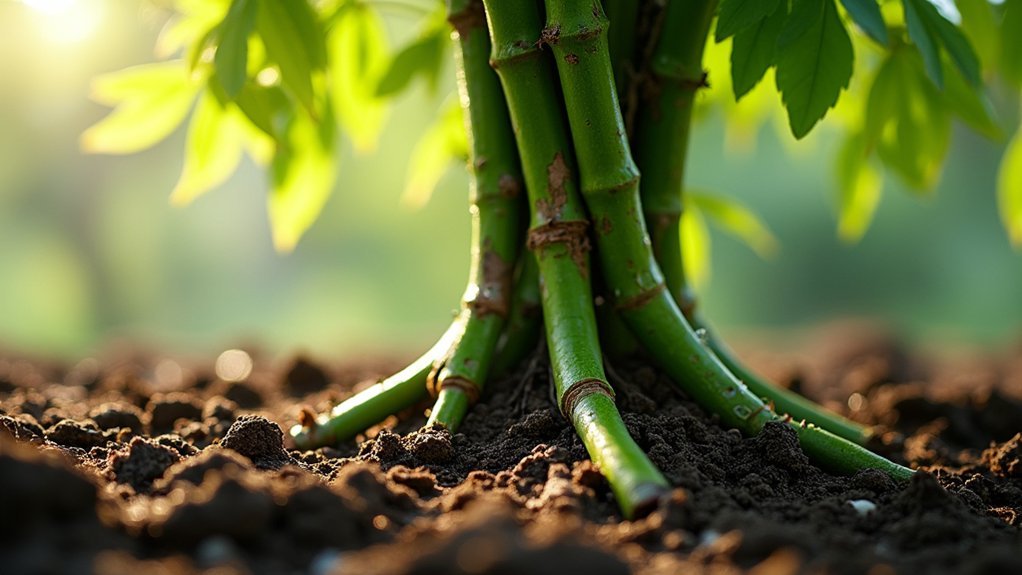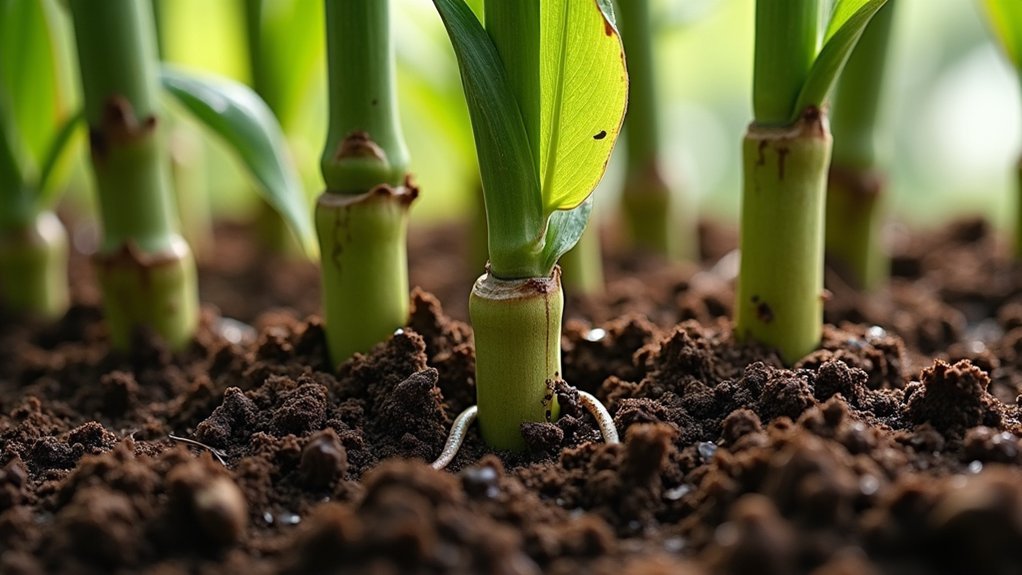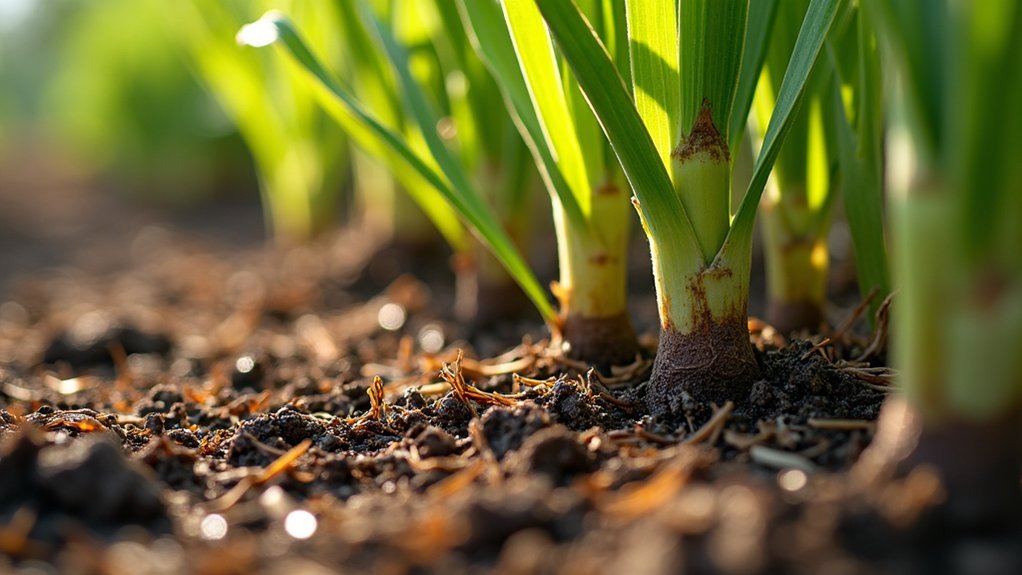Willow fences take root successfully due to their high concentrations of natural rooting hormones (IAA). You’ll need dormant cuttings planted at 45-degree angles with at least 6 inches in the ground during late fall to early spring. Confirm your site gets 6+ hours of sunlight with well-drained, consistently moist soil. Regular watering after planting eliminates air pockets and encourages root development. Proper mulching and seasonal care will transform these simple cuttings into living structures.
The Science Behind Willow’s Exceptional Rooting Ability

While most plants require specialized treatments to propagate from cuttings, willows stand apart with their remarkable ability to root almost effortlessly. This superpower stems from naturally high concentrations of IAA precursors—auxin-like compounds that trigger rapid root cell division.
The secret lies within willow’s vascular cambium, where undifferentiated cells quickly transform into root primordia under hormonal influence. Salicylic acid compounds work synergistically with these natural rooting hormones, improving stress resistance during propagation. This extraordinary rooting ability allows willow trees to develop extensive root systems that prevent soil erosion along riverbanks and streams.
Nature’s engineering marvel: willow’s cambium transforms into roots through hormonal alchemy, while salicylic compounds shield the developing cells.
You’ll find that even dormant growth factors remain active in mature willow cuttings over a year old. This explains why thick, pole-sized stems root successfully—they contain ample stored nutrients and potent hormone reserves.
This unique biology makes willows perfect for living fences, as cuttings rapidly establish themselves with minimal intervention.
Selecting the Perfect Site for Maximum Root Development
Because willows are remarkably adaptable, selecting the right planting location dramatically influences their rooting success and long-term fence viability.
Choose areas receiving at least 6 hours of direct sunlight daily, as inadequate light produces weak root systems.
Ensure soil depth reaches 18-24 inches without obstructions like shallow bedrock or excessive rocks. The ideal site offers well-drained soil that maintains consistent moisture without waterlogging. Check for natural mottling to confirm proper drainage. Willows can thrive in various conditions and create effective deer-resistant barriers when properly established.
Install your willow fence on gentle slopes or flat terrain to prevent erosion and maintain stable rooting conditions. For slopes, align plantings along contour lines for better moisture retention.
Time your installation for fall when soils remain moist but not frozen, or spring after thawing. Avoid frost-prone areas that could damage developing root systems.
Key Soil Preparation Techniques for Thriving Root Systems

How you prepare your soil directly determines the success of your willow fence’s root development. Start by thoroughly clearing grass and weeds to maximize soil exposure.
Loosen the soil to about 10 inches deep, creating an inviting environment for young roots to establish themselves. Work compost into your soil to enhance fertility and drainage—willow isn’t fussy about soil type, but it thrives in well-prepared ground. Choose a location with moisture-retentive soil and full sun exposure for optimal growth conditions.
For best results, dig a trench approximately six inches deep, spacing planting holes one meter apart. Plant your willow rods at a 45-degree angle and firm the soil lightly around them.
Fall or early winter planting offers ideal rooting conditions when the soil remains workable. Remember to mulch around stems to retain moisture and suppress weed competition.
Choosing Rod Quality That Ensures Successful Establishment
When selecting willow rods for your fence, you’ll find that diameter greatly impacts rooting success, with one-year flexible rods ideal for weaving and three-year thicker stems providing sturdy support as stakes.
The origin of your rods matters tremendously—freshly cut spring shoots with their regenerative capabilities will root more readily than older, dried-out material.
You’ll achieve the best structural integrity by combining different rod ages and thicknesses, ensuring both flexibility for weaving and rigidity for long-term stability. Planting should occur from late autumn to early spring when the willow is dormant, which significantly improves rooting potential and establishment success.
Diameter Drives Success
The diameter of your willow rods greatly impacts their rooting success and structural integrity. Select your rods strategically based on their intended function in your fence.
Thicker rods (three-year growth) make excellent stakes and uprights, providing the backbone of your structure. These sturdier pieces should be planted 12-18 inches deep, depending on soil conditions.
For diagonal supports, choose medium-thickness two-year rods that balance strength with some flexibility. Reserve your thinnest, most pliable one-year rods for weaving between supports.
When planting thicker structural rods, verify they’re soaked for at least 24 hours beforehand and cut at a sloping angle at the base to enhance water uptake and rooting potential. Make sure to space your main support rods 15cm apart for optimal growth and stability.
This diameter-based selection approach creates a fence with ideal structural support while guaranteeing successful establishment at all points.
Origin Matters Most
Quality of your chosen willow stock directly determines rooting success, as origin and cultivation history profoundly influence each rod’s viability. Select disease-free rods harvested during winter or early spring when the plant’s energy is concentrated in its stems.
Locally adapted varieties will establish more readily in your climate, while organically grown willows typically demonstrate greater vigor during root development. Living willow structures provide natural play spaces that grow and change with the seasons.
| Rod Characteristic | Impact on Rooting | Selection Tip |
|---|---|---|
| Harvesting season | Affects vigor | Choose winter-cut rods |
| Moisture content | Enables flexibility | Soak dry rods before planting |
| Growth location | Determines adaptability | Select climate-appropriate varieties |
| Cultivation method | Influences health | Prefer organic sources |
| Age of parent plant | Affects liveliness | Choose from mature, healthy stock |
Remember that proper moisture content is essential—excessively dry rods may need soaking before they’ll become pliable enough to work with or take root successfully.
Optimal Planting Depth and Angle for Strong Root Formation

Successfully establishing living willow fences depends largely on proper planting depth and angle, which directly influence root development and structural integrity.
You’ll want to insert your structural whips at a 45-degree angle to balance stability with growth potential, while using vertical placements for primary support posts.
Confirm you’ve buried at least 15cm (6″) of each cutting, with anchor whips extending 30cm (12″) into the soil for maximum stability. Position at least two growth nodes below ground to encourage robust rooting.
For reliable establishment, maintain 20cm (8″) of soil contact along the buried portion.
When creating lattice patterns, alternate the direction of your 45-degree angles and space whips 15-20cm apart.
In windy sites, increase planting depth to prevent drying and confirm long-term success.
The best time to install your willow fence is during winter to early spring, allowing the stems to establish before the growing season begins.
Strategic Watering Practices During the Critical First Season
Water management represents the single most important factor in establishing living willow fences after proper planting. Your newly planted whips need immediate watering to eliminate air pockets and establish soil contact. During the first growing season, consistent moisture is vital for successful root development. Survival rates during the first season can exceed 90% with proper moisture management.
| Timing | Watering Need | Why It Matters |
|---|---|---|
| After planting | Thorough soaking | Eliminates air pockets, guarantees soil contact |
| First summer | Regular checks | Prevents drought stress during establishment |
| Dry periods | Increased frequency | Supports continuous root development |
Monitor soil moisture regularly and adjust your watering schedule based on rainfall patterns. In drought conditions, prioritize deep watering to encourage downward root growth. Adding mulch helps retain soil moisture, reducing watering frequency while maintaining essential hydration levels for your developing willow fence.
Mulching Methods That Promote Healthy Root Growth

Proper mulching forms the cornerstone of successful willow fence establishment, directly influencing root development and long-term health.
Apply a consistent 3-inch layer of clean wood mulch immediately after planting, leaving 5-8 inches of cutting exposed to prevent rot and maintain airflow.
Keep mulch 5-8 inches away from cutting bases while extending coverage beyond planting rows to suppress weeds.
Consider using paper landscape fabric underneath for additional weed control without hampering water penetration.
Using weed fabric with mulch creates an ideal environment for young willow cuttings while minimizing maintenance during the critical establishment phase.
- Choose wood chips or compost to retain moisture and gradually release nutrients
- Clear all perennial weeds before application to eliminate competition
- Apply mulch in early spring or late fall to coincide with natural moisture cycles
- Replenish annually when more than half has decomposed, removing any infiltrating weeds first
Common Root Development Issues and Their Solutions
While excellent mulching practices create the foundation for thriving willow fences, even the best-prepared plantings can encounter root development challenges. You’ll need to address these issues promptly to guarantee your living fence thrives. Our project utilized permeable plastic mulch specifically to manage weed competition while maintaining proper soil moisture levels for optimal willow establishment.
| Issue | Impact | Solution |
|---|---|---|
| Moisture stress | Wilting, stunted growth, fence failure | Install irrigation system; apply deep watering twice weekly |
| Root competition | Weak establishment, poor stability | Clear vegetation within 1m radius; apply selective herbicide |
| Structural interference | Damaged foundations, cracked paving | Plant willows at least 3m from buildings; install root barriers |
Watch for signs of aphid infestation, which can indirectly weaken root development by reducing plant vigor. Control these pests early, as poor shoot health translates to inadequate root growth. Remember that willow roots dislike disturbance, so avoid transplanting established fences whenever possible.
Seasonal Considerations for Root System Management

Your willow fence’s root development relies heavily on when you plant and how you adapt care throughout the year.
Plant dormant cuttings in early spring after frost danger passes but before soil warms excessively, while reserving fall planting only for mild climates with proper mulching.
You’ll need to water deeply but infrequently during summer drought, then reduce irrigation in fall to prepare roots for winter dormancy, protecting young systems with mulch to buffer against destructive freeze-thaw cycles. When establishing new willow structures, cut replacement stems at a sharp angle for easier ground insertion and better rooting potential.
Spring vs. Fall Planting
Selecting the ideal planting time considerably impacts how successfully your willow fence whips establish root systems.
Spring planting leverages dormancy break, allowing roots to activate as sap rises in warming soils above 40°F. This timing synchronizes root establishment with shoot growth, creating maximal energy allocation. Proper soil preparation is vital when establishing willow whips to ensure optimal root development and growth.
Fall planting offers different advantages through dormancy-phase installation that minimizes transplant shock while roots develop without competing with active shoots.
- Spring’s natural moisture reduces irrigation needs compared to fall planting
- Early spring planting must occur before budburst for best results
- Fall-planted whips require strict dormancy adherence from November through April
- Spring installation enables more effective weed management strategies
Choose spring when you want immediate growth and natural moisture; select fall when dormancy benefits and reduced stress are priorities.
Seasonal Watering Strategies
Proper watering forms the cornerstone of successful willow fence establishment, requiring strategic adjustments throughout seasonal cycles.
During the first growing season, provide at least 1 inch of water weekly, increasing to twice-weekly during summer heatwaves. Early morning irrigation before 10am minimizes evaporation losses. Water thoroughly during dry spells, particularly in the first year to ensure root development and structural stability.
Use soaker hoses or drip systems to target the root zone directly while avoiding overhead sprinklers that promote fungal growth.
Apply 5-7cm of organic mulch around stems to retain moisture and suppress weeds.
For windy or sandy sites, increase watering frequency by 20-30%.
After 2-3 years, you’ll need less frequent watering, but don’t neglect moisture during dormancy.
Watch for curled leaves or soft shoots—these signal immediate deep watering needs, especially for newly planted specimens.
Frost Impact Management
Frost poses a significant challenge to establishing willow fences, particularly for developing root systems that need protection beyond regular watering routines.
You’ll have greater success by timing your planting after the risk of hard frost has passed when soil begins warming. This guarantees cuttings develop roots rather than rot in cold soil.
To protect your willow fence from frost damage:
- Apply a 3-inch layer of mulch around the base to insulate soil and maintain consistent temperatures
- Avoid planting in low spots where cold air pools, increasing freeze risk
- Select sites with good drainage to prevent frost heaving that exposes roots
- Inspect plantings during late fall and early spring, replacing damaged sections promptly
Regular maintenance through seasonal shifts will help your living fence establish strong roots despite frost challenges. Willow’s dormant harvesting period from December through March provides the ideal time to collect materials for repair or expansion of frost-damaged sections.
How Established Root Networks Support Fence Longevity
When willow fences take root, they transform from simple barriers into dynamic living structures with remarkable longevity benefits. Your fence’s mature root system provides thorough stabilization by anchoring posts against environmental stressors and distributing weight across multiple support points.
These established networks actively adapt to challenges, with roots growing strategically toward nutrient-rich zones and self-repairing when damaged. The root-soil relationship creates ideal conditions for fence durability—improving drainage, preventing compaction, and buffering pH fluctuations that could damage wood preservatives. Unlike traditional fencing that requires regular inspections and maintenance to extend its lifespan, living willow structures naturally regenerate.
As your fence ages, its tensile strength improves through lignin-rich older roots that resist fracture. The mycorrhizal partnerships and hydraulic systems guarantee continuous structural integrity even during drought periods.
This living foundation consistently outperforms traditional fence installations, with roots regulating moisture and actively preventing the rapid rot cycles that plague conventional wooden posts.
Enhancing Root Health Through Proper Maintenance Practices
While established root networks provide the foundation for your living fence, regular maintenance transforms these roots from merely surviving to truly thriving.
You’ll need to adapt your care routine to support underground development that strengthens your entire fence structure.
Focus on these essential practices:
- Water deeply once weekly rather than frequent shallow irrigation to encourage deep, resilient root systems
- Create excellent soil-to-stem contact when planting by using soil slurry and eliminating air pockets
- Redirect plant energy to roots by pruning excessive top growth and weaving new stems back into the fence
- Protect root zones from competition by maintaining weed-free areas and preventing soil compaction
During the critical first year, increase watering during dry spells and monitor for signs of stress that could compromise root establishment.
Frequently Asked Questions
Can Willow Fences Be Created With Decorative Patterns or Designs?
Yes, you can create willow fences with diamond patterns, vertical uprights, or horizontal weaves. You’ll find they’re highly customizable, allowing you to design living structures like tunnels or domes to match your garden style.
Will Willow Roots Damage Underground Utility Lines?
Yes, your willow roots can damage utility lines. They’re aggressive, seek moisture, and infiltrate cracks. Keep willows at least 30 feet from underground pipes, as their far-reaching roots will target any water source.
How Do Willow Fences Interact With Existing Garden Wildlife?
Willow fences create wildlife-friendly habitats that enrich your garden ecosystem. They’ll provide shelter, create corridors for movement, offer foraging opportunities, and reduce barriers that traditional fences present, supporting diverse creatures in your outdoor space.
Can Harvested Willow Rods Be Stored Before Planting?
Yes, you can store willow rods for up to six months in cool, dark conditions at 33-36°F with 60-70% humidity. You’ll get best results if you plant them within four months of harvesting.
Are Willow Fences Suitable for Creating Privacy in Urban Settings?
Yes, willow fences excel at creating urban privacy. You’ll appreciate how they block unwanted views, reduce noise, and create natural screening. They’re adaptable to tight spaces while adding aesthetic appeal to your urban setting.
In Summary
You’ll find that successful willow fencing comes down to understanding the plant’s natural rooting ability. When you’ve selected quality rods, prepared your soil properly, and planted at the correct depth and angle, you’re setting yourself up for success. Don’t forget to monitor seasonal changes and maintain proper care. With these fundamentals in place, you’ll enjoy a living fence that strengthens with each passing season as its roots establish.





Leave a Reply